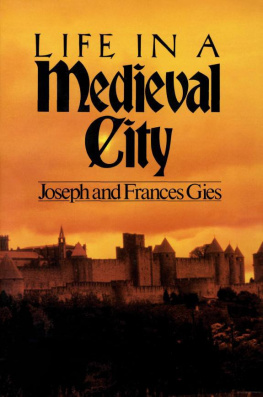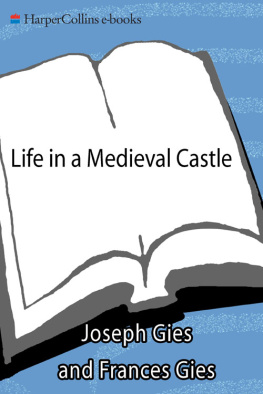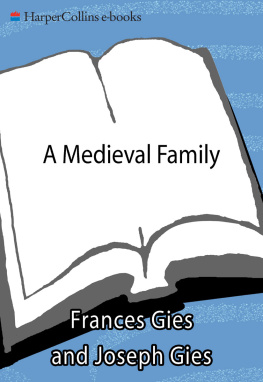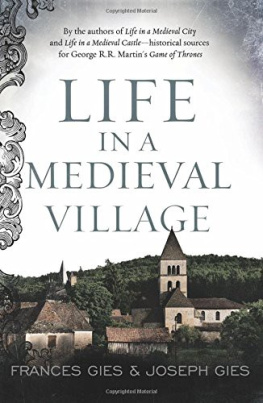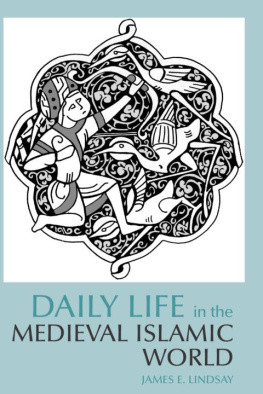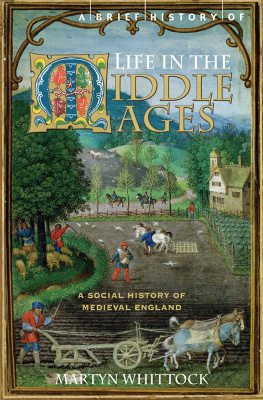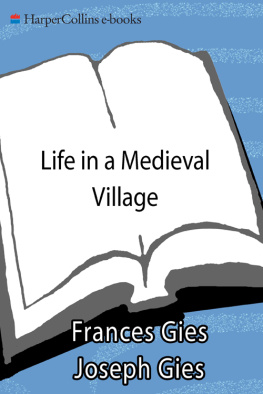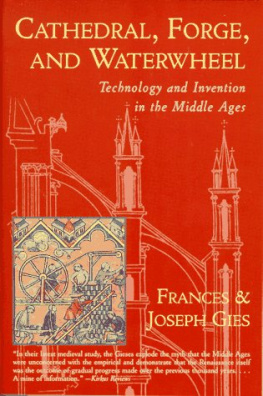Joseph Gies - Life in a medieval city
Here you can read online Joseph Gies - Life in a medieval city full text of the book (entire story) in english for free. Download pdf and epub, get meaning, cover and reviews about this ebook. year: 2014, publisher: Harper & Row, genre: History. Description of the work, (preface) as well as reviews are available. Best literature library LitArk.com created for fans of good reading and offers a wide selection of genres:
Romance novel
Science fiction
Adventure
Detective
Science
History
Home and family
Prose
Art
Politics
Computer
Non-fiction
Religion
Business
Children
Humor
Choose a favorite category and find really read worthwhile books. Enjoy immersion in the world of imagination, feel the emotions of the characters or learn something new for yourself, make an fascinating discovery.
- Book:Life in a medieval city
- Author:
- Publisher:Harper & Row
- Genre:
- Year:2014
- Rating:4 / 5
- Favourites:Add to favourites
- Your mark:
- 80
- 1
- 2
- 3
- 4
- 5
Life in a medieval city: summary, description and annotation
We offer to read an annotation, description, summary or preface (depends on what the author of the book "Life in a medieval city" wrote himself). If you haven't found the necessary information about the book — write in the comments, we will try to find it.
Life in a medieval city — read online for free the complete book (whole text) full work
Below is the text of the book, divided by pages. System saving the place of the last page read, allows you to conveniently read the book "Life in a medieval city" online for free, without having to search again every time where you left off. Put a bookmark, and you can go to the page where you finished reading at any time.
Font size:
Interval:
Bookmark:
Life in a Medieval City
Joseph and Frances Gies
To
Jane Sturman Gies
and
Frances Gibson Carney
Nos ignoremus quid sit matura senectus,
scire aevi meritum, non numerare decet .
Contents

T he western European city, with all its implications for the future, was born in the Middle Ages. By 1250 it was alive and flourishing, not only on the ancient Mediterranean coast but in northwest Europe. The narrative that follows is an attempt to depict life at the midpoint of the thirteenth century in one of the newly revived cities: Troyes, capital of the rich county of Champagne, seat of a bishop, and, above all, site of two of the famous Fairs of Champagne.
Back in the days when Julius Caesar camped in Gaul and bivouacked in Britain, there were few places in northwest Europe that could be called cities. Lutetia (Paris) was sufficiently important for Caesars Commentaries to record its destruction by fire. But in most of the region political organization was too undeveloped, commerce too scanty, and religion too primitive to permit the creation of communities larger than villages. Vast areas remained wilderness.
The Roman legions built roads, provided a market for local farm produce, and offered shelter to traders in their fortified camps. One place they fortified was a hamlet at the confluence of the Seine and an important military road, the Via Agrippa. Marcus Aurelius built a tower there, and later emperors, notably Aurelian, employed it as a base. Along with other camp towns, Tricasses took on the appearance of a permanent settlement as garrisoned soldiers married local girls, raised families, and stayed on after their discharges to farm outside the walls or perform craftsmens jobs inside. Graduating from army base to administrative center, the town acquired masonry walls and attracted new inhabitants: tax collectors, bureaucrats, army purveyors, and skilled and unskilled laborers, including prisoners of war brought back from the wilds of Germany and Friesland. Troyes hardly rivaled the opulent cities of Southern Europe or even Paris, which by the third century boasted three baths, a theater, and a racetrack. Troyes may have had one bath, which would have made it the equal in amenity of most of the other northern towns.
The Christian Church furnished a powerful new impetus to the development of many backwoods towns in the north, although the first apostles were not always appreciated by the pagan civil and religious authorities. At Troyes, as elsewhere, a number of martyrs were created by governors and emperors who held with the faith of their fathers. But once the Church had made a believer out of the Emperor Constantine, it had clear sailing. In the fourth and fifth centuries bishoprics sprang up all over the map. The natural place for a bishop to establish himself was in a Roman administrative center, usually a former legionary camp. The new clerical establishments required the services of a secular population of farmers and craftsmen. A new word described these episcopal towns cit (city)a derivation of the Latin civitas that usually took on the meaning of a populated place inside walls.
As the power of the Roman Empire faltered, local Roman officials lost their authority, creating a vacuum that was filled by Christian bishops. By the middle of the fifth century the prestige of the bishop of Troyes was such that when the Huns appeared in the neighborhood everyone turned to him for protection.
The town had just been sacked once by the Vandals, and Attilas Huns were reputed to be even less amicable. Bishop Lupus first sent a deacon and seven clerks to propitiate the enemy, but an unlucky accident caused the mission to miscarry. The clerics white vestments made Attilas horse rear. Concluding that his visitors were magicians, the Hun chieftain had them slain on the spot, one young clerk escaping to tell the tale. Attila then went off to fight the Romans, Goths, Burgundians, and Franks, who momentarily stopped fighting among themselves to take him on. Beaten, though not badly, Attila returned eastward, with Troyes directly in his path. It was an ominous moment, and once more everyone turned to Bishop Lupus. This time Lupus negotiated in person, and he scored a surprising success. Attila spared Troyes, and, taking the bishop with him as far as the Rhine, sent him home laden with honors. For this diplomatic feat Lupus was first denounced as a collaborator and exiled, but later, on sober second thought, restored to his see, to be eventually canonized as St.-Loup.
By the end of the fifth century the western half of the Roman Empire had slid into chaos. Nearly all the cities, old and new, large and small, declined catastrophically. People borrowed stones and bricks from public monuments to patch up their houses and strengthen walls against hordes of unwelcome immigrants. Commerce, already slowed down by a long-drawn-out, deeply rooted agricultural crisis, was nearly brought to a halt by the turmoil of the great migrations, or invasions, from the north and east. Towns like Troyes remained stunted, half military, half rural. Apart from crude ecclesiastical buildingsbishops palace, basilica-cathedral, the abbey and a couple of prioriesthe walls of Troyes enclosed only a few score hovels. Most of the towns forty-acre area was given over to vineyards, vegetable gardens, and pasturage.
Yet the marauding barbarians did contribute something to the growth of such settlements. After pillaging a Roman province, they set up a headquarters that generally metamorphosed into a petty capital. Reims, north of Troyes, became the capital of the Franks, and Troyes a Frankish sub-capital of Champagne. The Franks chief, Clovis, hardly less truculent a fellow than Attila, was more completely vanquished by St.-Rmi, bishop of Reims, than Attila had been by St.-Loup of Troyes. As St.-Rmi eloquently narrated the story of Jesus martyrdom, Clovis exclaimed, If only Id been there at the head of my valiant Franks! Clovis received baptism, and all his valiant Franks promptly did likewise.
In the sixth and seventh centuries a new ecclesiastical source of cities appearedthe Benedictine monastery. The institution spread rapidly, establishing itself sometimes in towns, sometimes in open country, and immediately attracting craftsmen, farmers, and traders. In the Bavarian forest appeared Monks TownMunich. In Flanders a Benedictine abbey built at the point where the river Aa becomes navigable formed the nucleus of the future manufacturing city of Saint-Omer.
On the Mediterranean littoral many of the old Roman cities did business in the Dark Ages much as they had done under the Empire. Marseilles, Toulon, Arles, Avignon, and other Provenal ports continued active commerce with the eastern Mediterranean. They imported papyrus and spices, for which the Benedictine monasteries helped provide a market. As a return cargo, the Provenal ships often carried slaves.
This state of affairs came to an end in the seventh century. The electrifying military successes of the followers of Mohammed in the Near East and North Africa were accompanied by a major dislocation of Mediterranean trade. Modern scholars have modified Henri Pirennes thesis on the causal connection between Mohammed and the Dark Ages, pointing out other influences at work. But it is fact that as Moslem fleets appeared in the western and central Mediterranean, the old Roman-Christian trading cities were thrown on the defensive and were frequently raided and pillaged. Genoa, once a busy port, declined to a fishing village. New cities, flying the banner of the Prophet, blossomed along the shores of North AfricaCairo, Mahdia, Tunis. Ancient Greek and Roman ports took on new life under the conquerors administration. In the harbor of Alexandria, guarded by the lighthouse that had been a wonder of the world for a thousand years, new shipyards furnished the vessels for Moslem commerce and piracy, the products of which, in turn, made Alexandrias markets the largest in the Mediterranean. One Christianif not exactly Europeanport was even busier: Constantinople, capital of the eastern Roman Empire, strategically seated astride major trade routes from east, west, north and south. But except for Greek Constantinople the Moslem merchants and raiders virtually took over the maritime world. In the eighth century their advance enveloped Spain and the Balearic Islands, and even a piece of Provence, from which foothold they raided all the ancient cities of the Rhne valley. One party roamed far enough north to sack Troyes.
Next pageFont size:
Interval:
Bookmark:
Similar books «Life in a medieval city»
Look at similar books to Life in a medieval city. We have selected literature similar in name and meaning in the hope of providing readers with more options to find new, interesting, not yet read works.
Discussion, reviews of the book Life in a medieval city and just readers' own opinions. Leave your comments, write what you think about the work, its meaning or the main characters. Specify what exactly you liked and what you didn't like, and why you think so.

